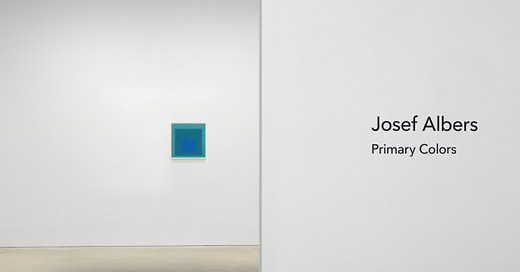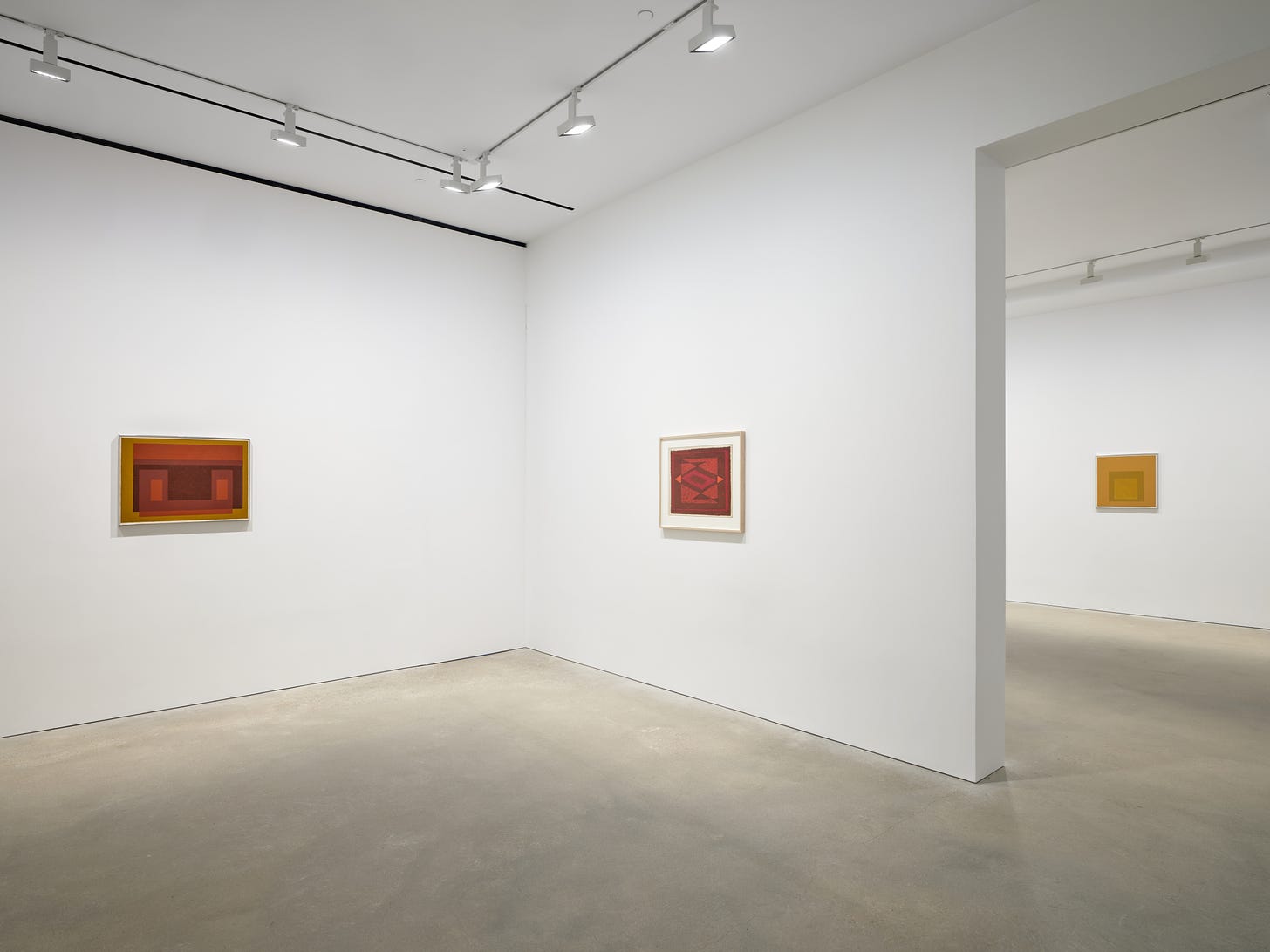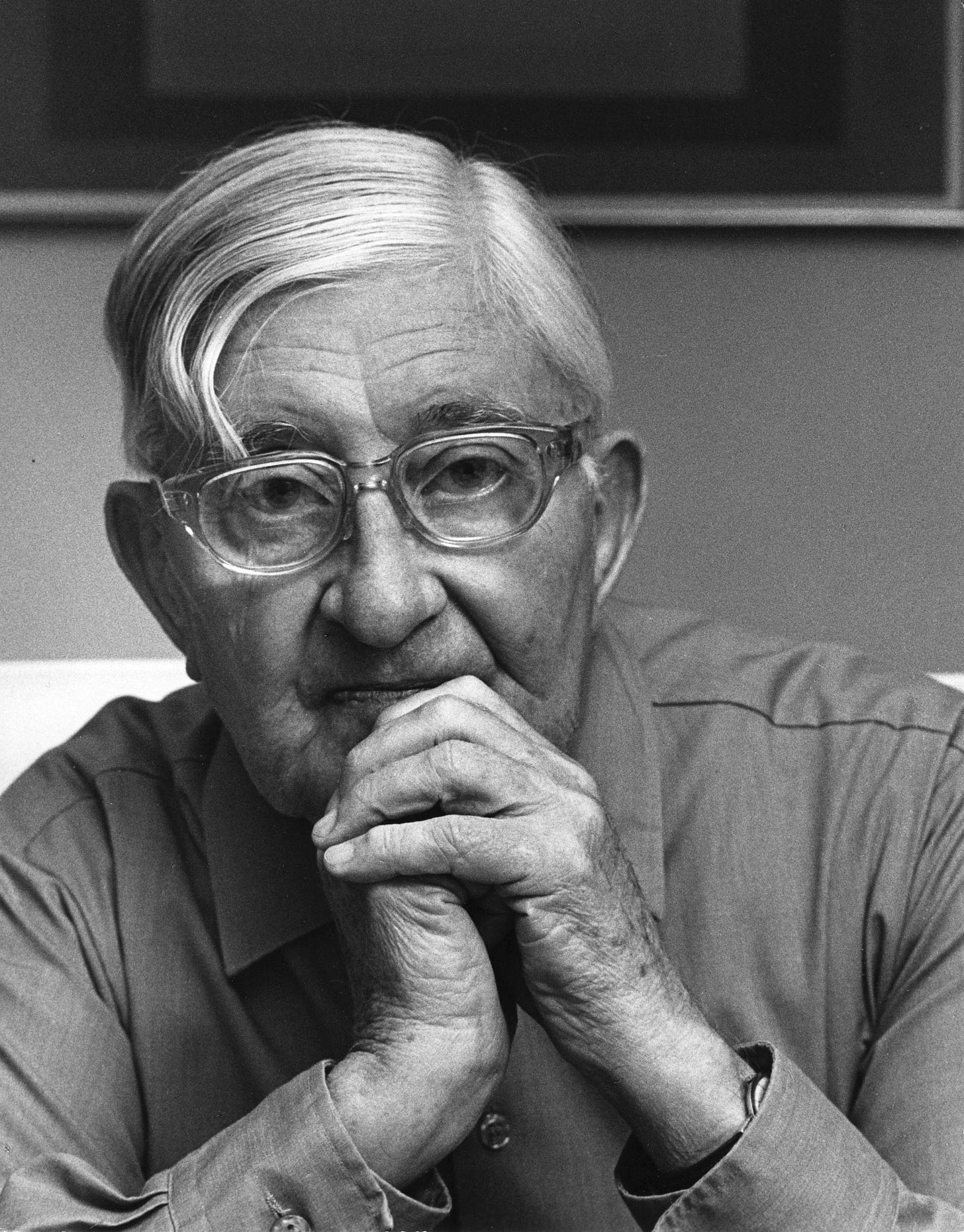Josef Albers | Primary Colors
Currently on view through 5 March 2022
David Zwirner, Hong Kong
5-6/F, H Queen’s, 80 Queen’s Road Central
David Zwirner is pleased to present Primary Colors, an exhibition of work by Josef Albers (1888–1976). On view at the gallery’s Hong Kong location, this will be the first solo presentation of Albers’s work in Greater China. Curated by Brenda Danilowitz, chief curator of The Josef and Anni Albers Foundation, the show is a focused examination of how the primary colors red, yellow, and blue, along with black, encompassed an infinite range of chromatic possibilities for Albers, which he explored throughout his career in stunning combinations presented in his signature visual formats. The exhibition coincides with a major retrospective exhibition of Albers’s and his wife and fellow artist Anni Albers’s art at the Institut Valencià d’Art Modern (IVAM), Valencia, Spain, which debuted at the Musée d’Art Moderne de Paris in 2021.
Josef Albers is considered one of the most influential abstract painters of the twentieth century as well as an important designer and educator. Albers’s artistic career, which bridged European and American modernism, consisted mainly of a tightly focused investigation into the perceptual properties of color and spatial relationships. Working with simple geometric forms, Albers sought to produce the effects of chromatic interaction, in which the visual perception of a color is affected by those adjacent to it. Albers’s precise application of color also created plays of space and depth, as the planar colored shapes that make up the majority of his works appear to either recede into or protrude out of the picture plane.
This exhibition will feature works by Albers from as early as the 1930s, a transitional period for the artist when he and Anni Albers immigrated to North Carolina, where they founded the art department at the famous Black Mountain College, and extending all the way to works he made shortly before his death in 1976. On view will be several paintings from Albers’s Homage to the Square series, his most celebrated body of work. These paintings were based on a nested square format that allowed Albers to experiment with endless chromatic combinations and perceptual effects. The artist has written about this work as follows: “Though the underlying symmetrical and quasi-concentric order of the squares remains the same in all paintings—in proportion and placement—these same squares group or single themselves, connect and separate in many different ways.”1 He has further written about how the colors in his paintings “are juxtaposed for various and changing visual effects. They are to challenge or to echo each other, to support or to oppose one another.... Such action, reaction, interaction—or interdependence—is sought in order to make obvious how colors influence and change each other; that the same color, for instance—with different grounds or neighbors—looks different.”2Works from Albers’s Variant/Adobe series, inspired by the artist’s travels in Latin America, and from an early, rare group of paintings that depicts the visual motif of the treble clef as well as several important paintings and studies for unique works comprised of polygons and other geometric forms will also be presented, illustrating the breadth of his formal and chromatic range.
Elaborating on the significance of color, and the primary colors in particular, as exemplified in the selection of works that will be on view, Danilowitz writes:
For Albers color had agency that equaled the agency of living organisms. He wanted, he said, “to make my colors breathe.” Color should be active and alive to the viewer who would ideally have “eyes open to see.” Color could be sensual—soft, hard, embracing, intersecting, and penetrating. By the mid-twentieth century Albers knew and trusted his material so well that he was able to completely submerge his ego and leave it to the viewer to observe that the artist, having performed his experiments with care and attention, could stand back and allow the material alone to work its magic. “Color is a magic force,” he proclaimed.
Albers understood that “primary colors” were an idealized version of what color is: that color identity was a subjective phenomenon and contingent on the individual viewer. Color wheels and color charts were attempts to codify color in scientific ways that had little relevance for him, and he avoided them. “If one in a group says ‘red,’” he wrote, as a statement for a 1952 exhibition at the Sidney Janis Gallery in New York, “we can be sure that there are as many different conceptions of red as there are individuals in that group.” A red painting was never simply a red painting, and he would prove it by using three or four different reds in a single Homage to the Square painting and repeating this practice with a range of reds, over and over again. There is no “primary” red, or blue, or yellow.
Josef Albers (1888–1976) was born in Bottrop, Germany, and studied briefly at the Königliche Bayerische Akademie der Bildenden Künste, Munich, in 1919 before becoming a student at the Weimar Bauhaus in 1920. In 1922, Albers joined the school’s faculty, first working in stained glass and, starting in 1923, teaching design. During his time at Black Mountain College, Albers began to show his work extensively within the United States, including solo exhibitions at the Addison Gallery of American Art, Andover (1935); J. B. Neumann’s New Art Circle, New York (1936, 1938); The Germanic Museum at Harvard University, Cambridge (1936); Katharine Kuh Gallery, Chicago (1937); San Francisco Museum of Art (1940); and the Nierendorf Gallery, New York (1941). The Alberses remained at Black Mountain until 1949 and in 1950 moved to New Haven, Connecticut, where Josef Albers was invited to direct a newly formed department of design at Yale University School of Art. In 1950, too, he developed what would become his seminal Homage to the Square series, which he continued to elaborate until his death in 1976. This body of work was featured in a major exhibition organized by The Museum of Modern Art, New York, in 1964 that traveled to twenty-two venues in the United States and Latin America. Albers retired from teaching in 1958, a few years prior to the publication of his important text Interaction of Color (1963), which was reissued in two volumes in 2013. Following numerous gallery and museum exhibitions, as well as his participation in documenta 1 (1955) and documenta 4 (1968), Albers became the first living artist to be the subject of a solo exhibition at The Metropolitan Museum of Art, New York, with his career-spanning retrospective there in 1971.
More recent exhibitions include Painting on Paper: Josef Albers in America, which originated at the Pinakothek der Moderne, Munich, in 2010 (traveled to Josef Albers Museum, Quadrat, Bottrop, Germany; Louisiana Museum of Modern Art, Humlebæk, Denmark; Kunstmuseum Basel; Centre Georges Pompidou, Paris; Centro de Arte Moderna, Gulbenkian Museum, Lisbon; and the Morgan Library and Museum, New York); Josef Albers: Minimal Means, Maximum Effect at the Fundación Juan March, Madrid, in 2014 (traveled to Henie Onstad Art Centre, Høvikodden, Norway); and A Beautiful Confluence: Anni and Josef Albers and the Latin American World at MUDEC, Museo delle Culture, Milan, in 2015 to 2016. From 2016 to 2017, The Museum of Modern Art, New York, presented One and One Is Four: The Bauhaus Photocollages of Josef Albers. In 2017, Josef Albers in Mexico was presented at the Solomon R. Guggenheim Museum in New York and traveled to the Peggy Guggenheim Collection in Venice in 2018. Anni and Josef Albers: Art and Life is currently on view through January 9, 2022 at the Musée d’Art Moderne de Paris, and opens at Institut Valencià d’Art Modern (IVAM), Valencia, Spain, on February 15, 2022.
Since May 2016, The Josef and Anni Albers Foundation has been exclusively represented by David Zwirner. The gallery’s first solo exhibition of Albers’s work, Grey Steps, Grey Scales, Grey Ladders in New York in 2016, was followed by Sunny Side Up at the London gallery in 2017, and Sonic Albers, which was on view in New York in 2019. Albers and Morandi: Never Finished, an exhibition exploring the visual and formal affinities and contrasts between the work of Albers and Giorgio Morandi, was on view in New York in 2021.
Our January Playlist | Youtube | Instagram | Facebook
If you love what we’re doing, please consider subscribing or you may also support us on Patreon
Josef Albers, “On My Homage to the Square” (c. 1954), first published in Josef Albers on His Seventieth Birthday. Exh. cat. (Freiburg: Kunstverein Freiburg, 1958), pp. 14–15, reprinted in Nicholas Fox Weber et al., Josef Albers: Minimal Means, Maximum Effect. Exh. cat. (Madrid: Fundación Juan March, 2014), p. 279.
Josef Albers, “The Color in My Painting” (c. 1954), first published in Josef Albers on His Seventieth Birthday, pp. 14–15, reprinted in Josef Albers: Minimal Means, Maximum Effect, p. 277.








